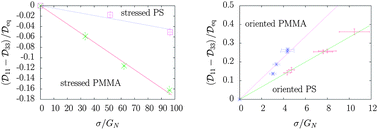Molecular origins of anisotropy in the thermal conductivity of deformed polymer melts: stress versus orientation contributions
Abstract
Amorphous

* Corresponding authors
a Department of Chemical and Biological Engineering, Physics Department, Center for the molecular study of condensed soft matter, Illinois Institute of Technology, 3440 S. Dearborn Street, Chicago, IL 60616-3793, USA
b Department of Chemical and Biological Engineering, Center of Excellence in Polymer Science and Engineering, Center for the molecular study of condensed soft matter, Illinois Institute of Technology, 3440 S. Dearborn Street, Chicago, IL 60616-3793, USA
c Department of Chemical and Biological Engineering, Center for the molecular study of condensed soft matter, Illinois Institute of Technology, 3440 S. Dearborn Street, Chicago, IL 60616-3793, USA
Amorphous

 Please wait while we load your content...
Something went wrong. Try again?
Please wait while we load your content...
Something went wrong. Try again?
J. D. Schieber, D. C. Venerus and S. Gupta, Soft Matter, 2012, 8, 11781 DOI: 10.1039/C2SM26788H
To request permission to reproduce material from this article, please go to the Copyright Clearance Center request page.
If you are an author contributing to an RSC publication, you do not need to request permission provided correct acknowledgement is given.
If you are the author of this article, you do not need to request permission to reproduce figures and diagrams provided correct acknowledgement is given. If you want to reproduce the whole article in a third-party publication (excluding your thesis/dissertation for which permission is not required) please go to the Copyright Clearance Center request page.
Read more about how to correctly acknowledge RSC content.
 Fetching data from CrossRef.
Fetching data from CrossRef.
This may take some time to load.
Loading related content
